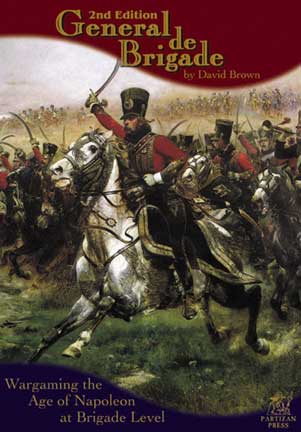|
|
|||||||||||||||||||||||||||||
 |
|
The Rules Directory only works if you help. Write a review. Get the review template here. |
|
TITLE : General de Brigade 2nd Edition (1999) AUTHOR: David Brown PUBLISHER: Partizan Press PUBLICATION DATE: 1999 WEB SITE/SUPPORT FORUM:
PRICE (with date): $30.00 (in 2008) REVIEWED BY: Mark “Extra Crispy” Severin PERIOD COVERED:
THE BOOK: General de Brigade (GdB) is a nice glossy staple bound book. It runs 68 pages not counting several pages of ads. There are extensive illustrations throughout. The interior is black & white. SCOPE: GdB is a tactical rule set for Napoleonic warfare. ARMY SIZE: Units in GdB tend to be fairly large (this is often cited as one of the appeals of the game). For example, a French line infantry battalion has 36-40 figures. The French army from the Vimiero scenario (included in the rules) totals 270 infantry figures, 12 cavalry figures and 3 guns with crew. BASE UNIT: Basic units are battalions for infantry, companies or squadrons for cavalry and batteries for artillery. In addition officer figures are required. GAME SCALES:
BASING SIZES: In all cases base depths should simply be kept as small as needed to mount the miniatures. 15mm Figures
25mm Figures
TURN SEQUENCE: Initiative Phase: Initiative is decided by a die roll. The winner (called the Phasing Player) may move first or make his opponent do so.
GAME MECHANICS: Command and Control: GdB is an order driven game. Orders are issued by C in C’s to their brigades. Once ordered, a brigade must act on those orders unless given a new order by the C in C or by initiative (one brigade per player per turn may attempt to change orders). Orders are written and must include specific objectives. Orders and order changes are affected by C in C quality, distance etc. Fire Combat: Fire Combat is fairly straight forward. A firing unit rolls 2D6, applies a number of modifiers for cover, enemy formation, firing unit formation, and unit quality. The result is cross indexed with the number of figures firing. The result is a number which is the number of casualties caused. Artillery fires in exactly the same way, but uses a separate set of tables. Melee Combat: Melees are resolved by opposed 2D6 die rolls. The high roll is the winner. The difference between the two rolls determines the extent of the victory. Modifiers include troop type (Cuiraissers get +3), morale (conscripts -1), and situations (-6 for retreating units, +2 for being in buildings). If the difference is big enough, the loser can break and be pursued by the victor. The die rolls also determine how many casualties each side inflicts on the other. Double Sixes: In many situations, if you roll 2D6 and roll box cars, you have to consult a Double Six chart. Results of this chart focus primarily on leader casualties, but extra casualties, morale results and retreats can also result. It is also possible for a leader to gain an inspirational bonus, or be killed owing to owning a cheap pocket watch (first rate pocket watch owners are safe and continue in the battle). ARMY LISTS/SCENARIOS: Included in the rule book is a section on OOBs with scattered selections from the era, as well as three scenarios: Vimiero (1808), Borodino – The Great Redoubt (1812) and Waterloo – The Guard’s Last Attack (1815). A simple points system for generating “what if” battles is also included. There are also books of scenarios available separately. REVIEWER’S COMMENTS: General de Brigade is arguably one of the most successful rules sets ever published. The rules themselves are well written, with copious examples and, where needed, illustrations. The mechanics are straightforward so are easy to both teach and learn. The same core game has also been adapted to a number of other periods including the 19th century (“There Are Your Guns”), the American War of Independence (“British Grenadier”) and numerous other adaptations are in the works. The primary criticism I have heard leveled at the game is that units are big and so a game requires a substantial number of figures to play. PLAYER’S COMMENTS: Not played. To read comments by others or leave one yourself, please click here |
|
[Home] [15mm World] [Reviews Home] [How To] [Beginners Guide] [Gamer's World] [Spanner & The Yank] [Points of View] [The Annex] [Links] [Say Howdy] [Corporate Schill] [Rules Directory] |
 |
